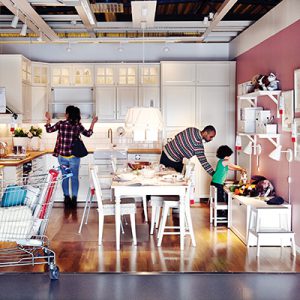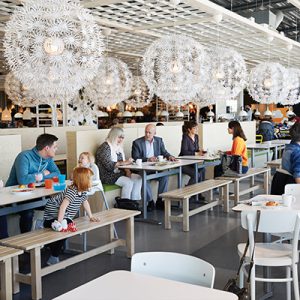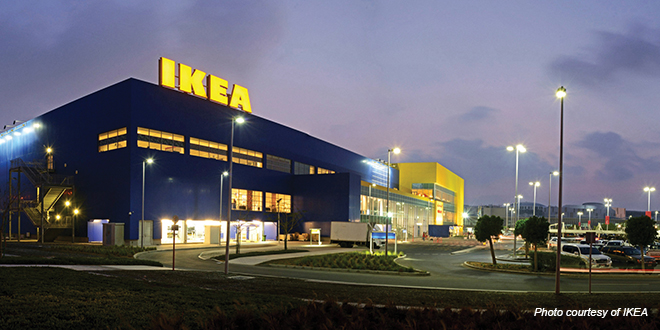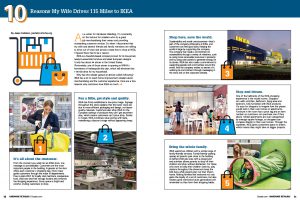Click the picture to download a PDF of this story.
As a writer for Hardware Retailing, I’m constantly on the lookout for retailers who do a great job merchandising their wares and providing outstanding customer service. So when I discovered that my wife and several friends and family members are willing to drive out of town and across a state line to shop at IKEA, I figured there had to be a reason.
IKEA is a Swedish-based company known for its low-priced, ready-to-assemble furniture and sleek European designs. It only has about 44 stores in the United States. (Fortunately, one of those stores is opening in NRHA’s hometown of Indianapolis this year, which will eliminate that 115-mile drive for my household).
Why has this retailer gained an almost cultish following? IKEA has a lot to teach home improvement retailers about merchandising and the customer experience. Here are a few reasons why customers love IKEA so much.
1. It’s all about the customer.
From the moment you walk into an IKEA store, one message is unmistakable: Customers are the most important people in the building. A greeter at the door offers each customer a shopping bag. Store maps guide customers through the maze of departments. Free in-store Wi-Fi for loyalty club members, inexpensive food, child care and free storage lockers also enhance the shopping experience. Every space is bright and colorful, inviting customers to shop.
2. Pay a little, get style and quality.
IKEA has firmly established a low-price image. Signage throughout the store explains that the lower costs are due to more efficient packaging and design, not lesser quality materials. Customers also shop IKEA for the European stylings of products they can’t get anywhere else, which means customers can’t price shop. Similar to Target, IKEA combines value pricing with style, maintaining a discount image without appearing cheap.
3. Shop here, save the world.
Sustainability and social consciousness—that’s part of the company philosophy at IKEA, and customers can feel good about helping the world at large by supporting the company. The company has made a commitment to sustainability through a variety of initiatives, such as using more renewable resources in products and by using solar panels to generate energy for its stores. IKEA has also made a commitment to supporting people and communities around the world. And the company makes no secret of it, outlining its commitment through messaging in the store and on the corporate website.

4. Stop and dream.
One of the hallmarks of the IKEA shopping experience is the model rooms. Shoppers can walk in a kitchen, bathroom, living area and bedroom, fully furnished with IKEA products. It’s easy for shoppers to imagine how the pieces would look in their own homes or apartments. Furniture in the room has a price tag and an item number so customers can purchase one if they desire. Model apartments are even categorized by average square footage, so shoppers can compare directly to their own homes. Through the vignettes, IKEA gives customers space to dream, which means they might take on bigger projects.
5. Bring the whole family.
IKEA welcomes children with a whole range of family-friendly services. Family-friendly parking spaces let parents park close to the building. A staffed child care area with a playground and activities allows parents to drop off their children and shop without distraction. For those who want to keep their children close by, play stations throughout the showroom keep the kids busy while parents plan out their dream home. Making families feel welcome not only gains the loyalty of a set of customers, but also creates good memories future generations will remember as they form their shopping habits.
6. Eliminate the stress.
Shoppers don’t have to maneuver large boxes throughout the store as they’re shopping IKEA. Kiosks offer shopping cards, pencils and disposable tape measures. Shoppers simply write down the numbers of the pieces of furniture they would like on the card. Help desks and special-order stations offer help whenever customers need it. Then, just before checking out, shoppers pick up their desired items from warehouse racking in one central location and load them on carts. At that point, they are just a few feet away from the cashier station and a covered loading area.
7. Buy on impulse.
Scattered throughout the IKEA showfloor are bins filled with items that complement the furniture and accessories on the floor. For example, a basket of throw blankets may be next to the sofa display. Since those add-ons are all relatively inexpensive, customers are likely to add them to their shopping carts. In fact, customers seem to appreciate having all the items they might need for a particular room of the house all in one place, as it saves them time and helps them coordinate accessories.

8. Some people enjoy putting that stuff together.
IKEA furniture comes unassembled in a box with a set of instructions. Some customers have a sense of pride at owning a piece of furniture they put together themselves. For those who want another option, the company offers an assembly service for a fee. Other customers may consider the cost of assembly and choose to spend that money on additional items instead.
9. Love it or bring it back.
It’s easy to return merchandise at IKEA. A heart-shaped caricature on signage throughout the store reminds customers that anyone dissatisfied with their purchase can bring it back within 90 days for a refund. Some items, such as mattresses, offer a 365-day return policy under certain conditions. Customers may be more likely to make a purchase if they know they have the option of changing their minds later. IKEA also clearly states the terms of the return up front so customers understand the policy before they make the purchase.

10. Meatballs and cinnamon rolls!
Why does a furniture store sell food? IKEA’s Swedish meatballs seem to be one of its most popular items. Most IKEA stores include a cafeteria with plated meals, as well as a cafe for quick eats. Customers love the ability to eat and shop, and it makes them stay longer. The food also reinforces the store’s price image. If you can buy a meatball dinner for $3.99 or a fresh cinnamon roll for $1, won’t everything else in the store be reasonably priced, too?
 Hardware Retailing The Industry's Source for Insights and Information
Hardware Retailing The Industry's Source for Insights and Information









